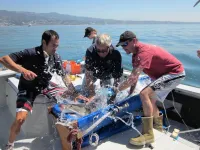INFORMATION:
Other contributors to this work include Carmen Gu Liu, Xue Ya, Shelley Gibson, Wilhem Salmen, Anubama Rajan, Hannah E. Carter, Justin R. Clark, Xuezheng Song, Robert F. Ramig, Barbara W. Trautner and Heidi B. Kaplan. The authors are affiliated with one or more of the following institutions: Baylor College of Medicine, Emory University, Michael E. DeBakey Veterans Affairs Medical Center and University of Texas Health Science Center at Houston.
This work is supported in part by a grant from U.S. Veterans Affairs (VA I01-RX002595), Roderick D. MacDonald Research Fund at Baylor St. Luke's Medical Center, the Mike Hogg Foundation and Baylor College of Medicine Seed Fund.
Phages can anticipate bacteria's location and destroy them before they cause an infection
2021-02-09
(Press-News.org) Researchers at Baylor College of Medicine and other institutions have identified a novel strategy that can eliminate bacteria in a specific location before they cause an infection. The strategy uses a phage, a virus that infects and destroys bacteria, that can specifically locate in the same place the bacteria live in the gastrointestinal tract. The proximity between phage and bacteria facilitates the phage's attack and subsequent elimination of the bacteria.
This strategy has the potential of becoming a game changer in the fight against antibiotic-resistant bacteria that live in hard-to-reach places, such as the mucus layer of the gut. The study appears in the journal mBIO.
"Phages are very specific in their ability to infect and destroy certain species or strains of bacteria and not others, such as good bacteria. In the U.S., phage therapy is increasingly becoming an available option to treat antibiotic-resistant bacterial infections, a serious health concern," said first author Dr. Sabrina Green, director of research and development for TAILΦR labs at Baylor.
Antibiotic-resistant bacteria, such as ExPEC ST131, can colonize the human intestine without causing disease, but they also can exit the gut and infect other organs. For instance, these bacteria have been associated with infections of the urinary tract, brain, peritoneum, peripheral organs, blood and in-dwelling devices, such as urinary catheters, vascular devices, feeding tubes and wound drains, resulting in 9 million infections per year.
The team showed in previous work that phages can effectively treat an infection caused by ExPEC ST131 bacteria. In this study, they wanted to see if they could use phages to remove these bacteria to prevent an infection.
Finding the right phage
Many phages have a hard time fighting bacteria in the gut. The team discovered that there is a factor present in mammalian intestines that prevents phages from destroying bacteria. They identified the factor as mucin, sticky proteins that form a layer between intestinal epithelial cells and the layer of microorganisms.
The researchers reasoned that although mucins prevent many phages from infecting bacteria, there may be some that have evolved a way to counter the effect of mucins and, as a result, are able to target bacteria in high-mucin environments.
"We screened human sewage and animal feces for phages with unique properties that facilitate their ability to destroy bacteria in the presence of mucins," said corresponding author Dr. Anthony Maresso, associate professor of molecular virology and microbiology at Baylor. "We discovered a novel phage called ES17 that binds to mucins, and this property seemed to enhance its ability to infect bacteria in mucin-rich environments, such as the gut."
Further studies looked closer at this novel phage-mucin interaction. Green, Maresso and their colleagues discovered that phage ES17 binds to particular molecules called heparan sulfate which can be found not only in mucins, but also on the surface of various cells types, including epithelial cells. This prompted the researchers to investigate whether binding to heparan sulfate on epithelial cells, which the researchers had also discovered is the same binding site used by ES17's host bacteria ExPEC, would contribute to ES17's ability to target and destroy the bacteria in the gut environment.
"We tested the effect of phage ES17 on its bacterial host ExPEC in a murine intestine, comparing it with phages known to be unable to infect their bacterial host in complex environments," Green said. "We found that only ES17 had the unique ability to target and eliminate ExPEC bacteria in animal models."
A novel strategy to prevent bacterial infections
Taken altogether, the findings suggest that the ability of phage ES17 to bind to heparan sulfate on mucin-rich surfaces and directly on mammalian epithelial cells mediates its localization in areas deep in the gut where reservoirs of bacteria may be present. The researchers propose that being close to ExPEC bacteria facilitates phage invasion and bacterial elimination before they have the opportunity to exit the gut and infect other organs.
"Phages are viruses that specialize in invading and eliminating specific bacteria. Here we have shown the first phage that also binds to epithelial human cells and that this property mediates a novel mechanism for fighting bacterial infections we call positional targeting, as it enables the phage to anticipate where the bacteria it targets will be located," Maresso said. "We foresee the possibility that positional targeting will be the way smart drugs work in the future. Drugs won't be just distributed all through the body in the hopes that some of it will end in the right spot. The drugs of the future will go only precisely where they are supposed to work. Our work with phages is the first case in which this has been achieved."
ELSE PRESS RELEASES FROM THIS DATE:
Program led by health coaches at primary care clinics helped reduce heart risk
2021-02-09
DALLAS, Feb. 9, 2021 -- Participants in a two-year, lifestyle intervention/weight-loss program provided through health coaches at their primary care center were able to lower their blood sugar and improve their cholesterol levels, according to new research published today in the American Heart Association's flagship journal Circulation Journal. Researchers with the PROmoting Successful Weight Loss in Primary CarE in Louisiana (PROPEL) Trial reported previously that participants also reduced body weight by an average of 5% and note that patients who lost more weight experienced greater improvements in their heart disease risk factors.
"Our results demonstrate lifestyle intervention and weight-loss programs can be successful for people in underserved, low-income ...
Coffee lovers, rejoice! Drinking more coffee associated with decreased heart failure risk
2021-02-09
DALLAS, Feb. 9, 2021 -- Dietary information from three large, well-known heart disease studies suggests drinking one or more cups of caffeinated coffee may reduce heart failure risk, according to research published today in Circulation: Heart Failure, an American Heart Association journal.
Coronary artery disease, heart failure and stroke are among the top causes of death from heart disease in the U.S. "While smoking, age and high blood pressure are among the most well-known heart disease risk factors, unidentified risk factors for heart disease remain," according to David P. Kao, M.D., senior author of the study, assistant professor of cardiology and medical director at the Colorado Center for Personalized Medicine at the University of Colorado School of Medicine ...
Limiting warming to 2 C requires emissions reductions 80% above Paris Agreement targets
2021-02-09
In 2017, a widely cited study used statistical tools to model how likely the world is to meet the Paris Agreement global temperature targets. The analysis found that on current trends, the planet had only a 5% chance of staying below 2 degrees Celsius warming this century -- the international climate treaty's supposed goal.
Now, the same authors have used their tools to ask: What emissions cuts would actually be required to meet the goal of 2 C warming, considered a threshold for climate stability and climate-related risks such as excessive heat, drought, extreme weather and sea level rise?
The University of Washington study finds that emissions reductions about 80% more ambitious than those in the Paris Agreement, or an average of 1.8% drop in emissions per year rather than 1% ...
New study finds climate change shrinks and shifts juvenile white shark range
2021-02-09
New research led by Monterey Bay Aquarium reveals that even the revered white shark cannot escape the impacts of a changing ocean. The study, published in Scientific Reports, finds that unprecedented sightings of juvenile white sharks at the northern end of Monterey Bay signal a significant shift in the young white sharks' range.
Researchers conclude the northward range shift demonstrates the young sharks are being subjected to a loss of suitable thermal habitat, meaning water temperatures within their preferred temperature range are becoming harder to find.
"Nature has many ways to tell us the status quo is being disrupted, but it's up to us to listen," said Monterey Bay Aquarium Chief Scientist Dr. Kyle Van Houtan. "These sharks - by venturing into territory where they have not historically ...
The invisible killer lurking in our consumer products
2021-02-09
Our consumer products, such as food, cosmetics and clothes, might be filled with nanomaterials - unbeknownst to us. The use of nanomaterials remains unregulated and they do not show up in lists of ingredients. This is a cause of concern since nanomaterials can be more dangerous than COVID-19 in the long term if no safety action is taken: they are tricky to measure, they enter our food chain and, most alarmingly, they can penetrate cells and accumulate in our organs.
Nanotechnology is appearing everywhere, to change our daily lives. Thanks to applications of nanotechnology, we can treat many diseases so efficiently that they'll soon be a thing of the past. We also have materials that are 100 times stronger than steel, batteries that last 10 times longer than ...
New factor in the carbon cycle of the Southern Ocean identified
2021-02-09
The term plankton describes usually very small organisms that drift with the currents in the seas and oceans. Despite their small size, they play an important role for our planet due to their immense quantity. Photosynthesizing plankton, known as phytoplankton, for example, produce half of the oxygen in the atmosphere while binding huge amounts of carbon dioxide (CO2). Since the Southern Ocean around Antarctica is very rich in nutrients, phytoplankton can thrive there. It is therefore a key region for controlling atmospheric CO2 concentrations.
As other nutrients are abundant, scientists have ...
Radiation vulnerability
2021-02-09
Exposure to radiation can wreak indiscriminate havoc on cells, tissues, and organs. Curiously, however, some tissues are more vulnerable to radiation damage than others.
Scientists have known these differences involve the protein p53, a well-studied tumor-suppressor protein that initiates a cell's auto-destruct programs. Yet, levels of this sentinel protein are often similar in tissues with vastly different sensitivities to radiation, posing the question: How is p53 involved?
A new study by researchers in the Blavatnik Institute at Harvard Medical School, Massachusetts General Hospital, and the Novartis Institutes for BioMedical Research now sheds light on this mystery.
Reporting in Nature Communications on Feb. 9, they describe how cellular survival after radiation exposure depends ...
Evidence for routine brain tumor imaging is murky, but research can shed light
2021-02-09
What is the best way to monitor a brain tumor? This question is at the heart of a new Position Statement published in open-access journal Frontiers in Oncology. The article is the work of a large collaboration of UK experts and stakeholders who met to discuss the value of routinely imaging brain tumor patients to assess their tumor treatment response, which is known as "interval imaging". Their verdict: there is very limited evidence to support the practice at present. However, the article also discusses how future research could determine and maximize the value of interval ...
Environmentally friendly behavior is easy -- tourists just need a 'nudge'
2021-02-09
A new study in Frontiers in Communication has demonstrated the powerful impact that subtle messaging and cues, or 'nudges', can provide on encouraging people to show socially desirable behaviors. Travelers who were observed on the Indonesian island of Gili Trawangan, a popular tourist destination, were more likely to demonstrate environmentally conscious actions, such as refusing a plastic bag or avoiding contact with a coral reef, when they were 'nudged' towards the desirable action with either a written or face to face interaction. The researchers found that any intervention, whether framed positively or negatively, was ...
Lockdown linked to drop in asthma attacks, GP data suggests
2021-02-09
Asthma attack rates seen at GP surgeries fell significantly during the first Covid-19 pandemic lockdown of 2020, a study suggests.
Lower levels of air pollution, fewer cold and flu infections, and the fear of attending doctor surgeries due to Covid-19 were possible reasons for the 20pc drop in cases seen at GP surgeries, researchers said.
The study is the first national review of lockdown effects on asthma attacks and includes data from more than 100,000 patients.
Asthma attacks - or exacerbations - are bouts of shortness of breath, wheezing or a tight chest. There are usually more than six million GP consultations and 1400 deaths attributed to asthma in the UK every year.
For the study researchers from the University of Edinburgh looked at a national GP database ...



